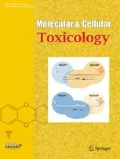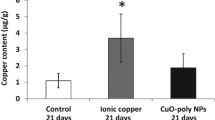Abstract
Nanomaterials composed of silver (Ag), copper-doped titanium dioxide (Cu-TiO2), and pure titanium dioxide (TiO2) have wide applications in consumer products such as cosmetics, electronic appliances, clothes, and industry materials such as solar cell. However, there are problems associated with the exposure of aquatic organisms in the ecosystem to such nanomaterials. In this study, we investigated the expression pattern of genes in zebrafish embryos after exposure to nanomaterials. We used several functional categories including apoptosis, endocytosis, immune response, and endoplasmic reticulum stress so on. A total of 314 (278 up-regulated and 36 down-regulated), 283 (129 up-regulated and 154 down-regulated), and 360 (198 up-regulated and 162 down-regulated) genes were differentially expressed in zebrafish embryos exposed to Ag, Cu-TiO2, and TiO2 NPs, respectively, with apoptosis being the function of the highest proportion of differentially expressed genes in all 3 NP exposures. Our data provide a basis for conducting further mechanistic studies of genes that are induced or suppressed upon exposure to NPs in zebrafish embryogenesis.
Similar content being viewed by others
References
Savolainen, K. et al. Risk assessment of engineered nanomaterials and nanotechnologies-A review. Toxicology 269:92–104 (2010).
Kokura, S. et al. Silver nanoparticles as a safe preservative for use in cosmetics. Nanomedicine 6:570–574 (2010).
Kim, J. S. et al. Antimicrobial effects of silver nanoparticles. Nanomedicine 3:95–101 (2007).
Asghari, S. et al. Toxicity of various silver nanoparticles compared to silver ions in Daphnia magna. J Nanobiotechnology 10:1–11 (2012).
Yeo, M. K. & Kang, M. S. Effects of nanometer sized silver materials on biological toxicity during zebrafish embryogenesis. Bull Korean Chem Soc 29:1179–1184 (2008).
Bilberg, K., Hovgaard, M. B., Besenbacher, F. & Baatrup, E. In vivo toxicity of silver nanoparticles and silver ions in zebrafish (Danio rerio). J Toxicol 2012:1–9 (2012).
Botta, C. et al. TiO2-based nanoparticles released in water from commercialized sunscreens in a life-cycle perspective: Structures and quantities. Environ Pollut 159:1543–1550 (2011).
Yang, Y. Z., Chang, C. H. & Idriss, H. Photo-catalytic production of hydrogen form ethanol over M/TiO2 catalysts (M=Pd, Pt or Rh). Appl Catal B 67:217–222 (2006).
Chao, C. S. et al. Bioactive TiO2 ultrathin film with worm-like mesoporosity for controlled drug delivery. Microporous Mesoporous Mater 152:58–63 (2012).
Mohan, L., Durgalakshmi, D., Geetha, M., Sankara Narayanan, T. S. N. & Asokamani, R. Electrophoretic deposition of nanocomposite (HAp+TiO2) on titanium alloy for biomedical applications. Ceram Int 38:3435–3443 (2012).
Roguska, A. et al. Characterization of a calcium phosphate-TiO2 nanotube composite layer for biomedical applications. Mater Sci Eng C Mater Biol Appl 31:906–914 (2011).
Clemente, Z., Castro, V. L., Jonsson, C. M. & Fraceto, L. F. Ecotoxicology of nano-TiO2-an evaluation of its toxicity to organisms of aquatic ecosystems. Int J Environ Res 6:33–50 (2012).
Yeo, M. K. & Kim, H. E. Gene expression in zebrafish embryos following exposure to TiO2 nanoparticles. Mol Cell Toxicol 6:97–104 (2010).
Zhu, X., Chang, Y. & Chen, Y. Toxicity and bioaccumulation of TiO2 nanoparticle aggregates in Daphnia magna. Chemosphere 78:209–215 (2010).
Qiu, S., Xu, S., Ma, F. & Yang, J. The photocatalytic efficiency of the metal doped TiO2 with ceramic foam as catalyst carriers. Powder Technology 210:83–86 (2011).
Feng, H., Zhang, M. H. & Yu, L. E. Hydrothermal synthesis and photocatalytic performance of metal-ions doped TiO2. Appl Catal A Gen 413–414:238–244 (2012).
Colón, G., Maicu, M., Hidalgo, M. C. & Navío, J. A. Cu-doped TiO2 systems with improved photocatalytic activity. Appl Catal B 67:41–51 (2006).
Carvalho, H. W., Batista, A. P., Hammer, P. & Ramalho, T. C. Photocatalytic degradation of methylene blue by TiO2-Cu thin films: theoretical and experimental study. J Hazard Mater 184:273–280 (2010).
Sahu, M. & Biswas, P. Single-step processing of copper-doped titania nanomaterials in a flame aerosol reactor. Nanoscale Res Lett 6:1–14 (2011).
Fan, W. et al. Nano-TiO2 enhances the toxicity of copper in natural water to Daphnia magna. Environ Pollut 159:729–734 (2011).
Yeo, M. K. & Park, H. G. Gene expression in zebrafish embryos following exposure to Cu-doped TiO2 and pure TiO2 nanometer-sized photocatalysts. Mol Cell Toxicol 8:127–137 (2012).
Pozzo, M. & Alfé, D. Hydrogen dissociation and diffusion on transition metal (=Ti, Zr, V, Fe, Ru, Co, Rh, Ni, Pd, Cu, Ag)-doped Mg (0001) surfaces. Int J Hydrogen Energy 34:1922–1930 (2009).
Zhang, R. et al. Endoplasmic reticulum stress signaling is involved in silver nanoparticles-induced apoptosis. Int J Biochem Cell Biol 44:224–232 (2012).
Ahamed, M. et al. Silver nanoparticles induced heat shock protein 70, oxidative stress and apoptosis in Drosophila melanogaster. Toxicol Appl Pharmacol 242:263–269 (2010).
Gross, A., McDonnell, J. M. & Korsmeyer, S. J. Bcl-2 family members and the mitochondria in apoptosis. Genes Dev 13:1899–1911 (1999).
Kelekar, A. & Thompson, C. B. Bcl-2 homology domains: the role of the BH3 domain in apoptosis. Trends Cell Biol 8:324–329 (1998).
Halappanavar, S. et al. Pulmonary response to surfacecoated nanotitanium dioxide particles includes induction of acute phase response genes, inflammatory cascades, and changes in microRNAs: a toxicogenomic study. Environ Mol Mutagen 52:425–439 (2011).
Yeo, M. K. & Kang, M. S. Effects of CuxTiOy nanometer particles on biological toxicity during zebrafish embryogenesis. Korean J Chem Eng 26:711–718 (2009).
Binaeian, E. et al. Comparative toxicity study of two different synthesized silver nanoparticles on the bacteria Vibrio fischeri. Afr J Biotechnol 11:7554–7564 (2012).
Valsami-Jones, E. et al. Nanomaterial synthesis and characterization for toxicological studies: TiO2 case study. Mineral Mag 72:515–519 (2008).
Wu, Q. et al. Comparison of toxicities from three metal oxide nanoparticles at environmental relevant concentrations in nematode Caenorhabditis elegans. Chemosphere 90:1123–1131 (2013).
Jaeger, A., Weiss, D. G., Jonas, L. & Kriehuber, R. Oxidative stress-induced cytotoxic and genotoxic effects of nano-sized titanium dioxide particles in human HaCaT keratinocytes. Toxicology 296:27–36 (2012).
Liu, H. et al. Comparative study of respiratory tract immune toxicity induced by three sterilisation nanoparticles: Silver, zinc oxide and titanium dioxide. J Hazard Mater 248–249:478–486 (2013).
Ranzinger, J. et al. Nanoscale arrangement of apoptotic ligands reveals a demand for a minimal lateral distance for efficient death receptor activation. Nano Lett 9:4240–4245 (2009).
Hsina, Y. H. et al. The apoptotic effect of nanosilver is mediated by a ROS- and JNK-dependent mechanism involving the mitochondrial pathway in NIH3T3 cells. Toxicol Lett 179:130–139 (2008).
Hansen, J. B. et al. Divalent metal transporter 1 regulates iron-mediated ROS and pancreatic β cell fate in response to cytokines. Cell Metab 16:449–461 (2012).
Harada, T., Iwai, A. & Miyazaki, T. Identification of DELE, a novel DAP3-binding protein which is crucial for death receptor-mediated apoptosis induction. Apoptosis 15:1247–1255 (2010).
Duan, Z. et al. Promoter polymorphisms in DNA repair gene ERCC5 and susceptibility to gastric cancer in Chinese. Gene 511:274–279 (2012).
Harada, T., Iwai, A. & Miyazaki, T. Toll-like receptors and innate immunity. Nat Rev Immunol 388:621–625 (2009).
Entrez Gene: M Vitronectin: Available online at http://www.ncbi.nlm.nih.gov/gene?Db=gene&Cmd=ShowDetailView&TermToSearch=7448.
Arya, M. et al. The importance of the CXCL12-CXCR4 chemokine ligand-receptor interaction in prostate cancer metastasis. J Exp Ther Oncol 4:291–303 (2004).
Wabnitz, G. H. et al. Costimulation induced phosphorylation of L-plastin facilitates surface transport of the T cell activation molecules CD69 and CD25. Eur J Immunol 37:649–662 (2007).
Chae, J. H. & Kang, M. S. Cubic titanium dioxide photoanode for dye-sensitized solar cells. J Power Sources 196:4143–4151 (2011).
The zebrafish book, a guide for the laboratory use of zebrafish (Danio rerio): Available online at http://zfin.org/zf_info/zfbook/zfbk.html.
Author information
Authors and Affiliations
Corresponding author
Rights and permissions
About this article
Cite this article
Park, HG., Yeo, MK. Comparison of gene expression changes induced by exposure to Ag, Cu-TiO2, and TiO2 nanoparticles in zebrafish embryos. Mol. Cell. Toxicol. 9, 129–139 (2013). https://doi.org/10.1007/s13273-013-0017-0
Received:
Accepted:
Published:
Issue Date:
DOI: https://doi.org/10.1007/s13273-013-0017-0



